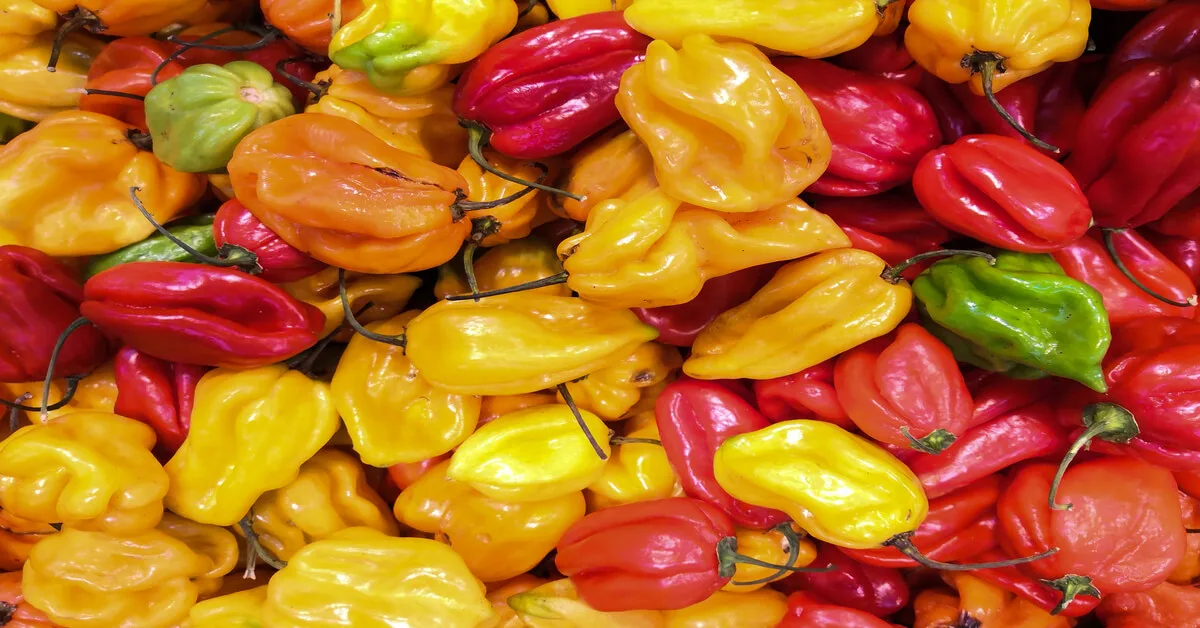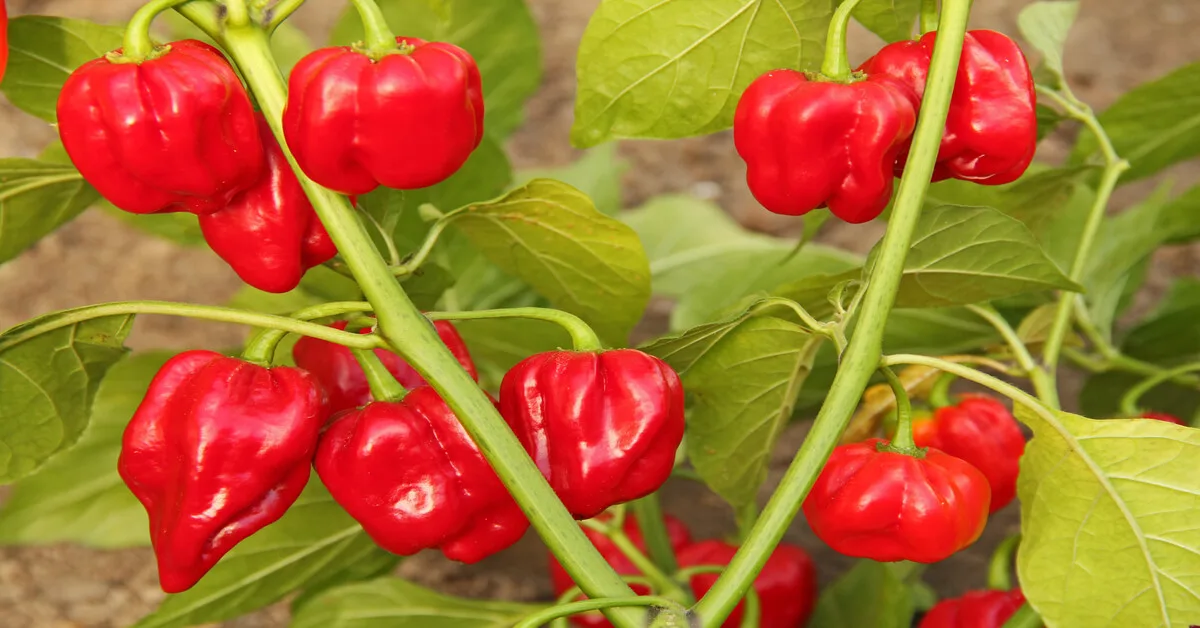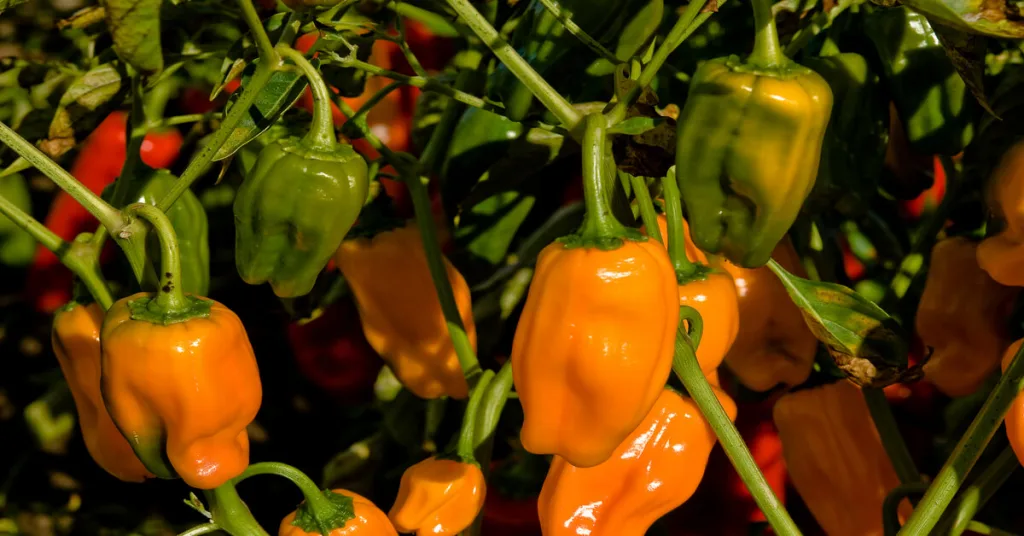Some of the links in this post are affiliate links. This means if you click on the link and purchase the item, I will receive an affiliate commission at no extra cost to you.
Habanero peppers (Capsicum chinense “Habanero”) belong to one of the spiciest species of commonly available hot chili peppers in the world.
Before the introduction of the exotic Carolina Reaper and Bhut Jolokia cultivars, habaneros were considered the spiciest peppers in the world.
Their smoky and citrus-like notes pack a flavorful and spicy punch perfect for making a chili sauce, drying into a chili powder, steeping in vodka, or for cooking a hot Mexican stir fry.
Below, we’ll go over everything you need to know about habaneros and how to grow them.
Habanero Origin
Habaneros are named after the Cuban city of Havana (or La Habana in Spanish), where it was traded and popularized around the world. However, habaneros originate from the Amazon Basin in South America.
The earliest habanero (Capsicum chinense) pod was found in a cave in Guitarrero in coastal Peru dating back to 6,500 B.C. [1]
From the Amazon basin, habaneros spread to the Caribbean, Central America, and Mexico before being introduced by the Spanish to Europe and the rest of the world.
Habaneros are often associated with Mexico, particularly the Yucatan peninsula, where ideal climatic conditions allowed habaneros to adapt and diversify.
Today, the Yucatan Peninsula is considered the center of diversity for chili peppers, leading the Mexican government to label habaneros as a protected designation origin (PDO) product in 2010. This means only habaneros cultivated in the Yucatan carry this PDO label. [2]
How Hot is a Habanero Pepper?

Habaneros are rated 150,000-350,000 on the Scoville Scale, making them far spicier than serrano, cayenne, and Thai chilies. In fact, they’re about 50-100x spicier than jalapeño peppers.
Habanero Plant Care
Habaneros are generally easy-to-care-for and warm-season plants that thrive in full sun (with partial shading in high heat) and organic-rich soils.
The Habanero can be seeded indoors 6-10 weeks before the last frost before transplanting or grown entirely in containers.
Habaneros grow best in rows spaced 30-36 inches (75-90 cm) apart, with 12-24 inches (30-60 cm) of spacing between plants within each row.
Below, we’ll go over everything else you need to know about cultivating habaneros.
Soil
Although habaneros can tolerate many types of soil, they do best in moist, well-draining, organic matter-rich, slightly acidic pH 6.0-6.8, and sandy loam soil.
You may want to grow habaneros in a raised garden bed if your garden has poor drainage.
Watering
Habaneros require about 1-2 inches of water weekly. Infrequent but deep waterings with a soaker hose or drip irrigation work best.
Some studies have shown that water-stressed habaneros (i.e. those that were watered every 7 days vs. a control of daily watering) produced fewer flowers but fruits with higher concentrations of capsaicin, which increases the pepper’s pungency and spiciness. [3]
Lighting
Habaneros do best in full sun (6-8 hours of sunlight).
Plant habaneros in a south-, west-, or east-facing window or slope for maximum light exposure. However, provide some shading if temperatures exceed 95°F (35°C) consistently.
Humidity & Temperature
Ideal daytime temperatures for habaneros are between 70-85°F (21-29°C) and ideal nighttime temperatures are 50-60°F (10-15°C).
Temperatures below 50°F (10°C) may kill plants and crops, and temperatures above 95°F (35°C) may inhibit germination and cause blossom drop and heat stress.
The ideal relative humidity is between 50-70%.
Fertilizing (NPK)
Habaneros produce better yields and spicier fruit with regular fertilization.
Fertilize with NPK 5-10-10 or 8-16-16 ratio (half as much nitrogen) fertilizers during planting and again every 2-4 weeks thereafter.
Switch to a high potassium 9-15-30 fertilizer once flowering begins to encourage fruit set.
Organic farmers can use a combination of fish emulsion, green sand, kelp meal, and bone meal to get similar results.
Diseases & Pests
Habaneros are prone to several diseases which commonly affect pepper plants such as bacterial leaf spot, mosaic virus, blight, verticillium wilt, anthracnose, phytophthora blight, wet rot, Cercospora leaf spot, southern blight, blossom-end rot, pepper mild mottle virus, and tomato spotted wilt virus.
Avoid planting habaneros and other peppers immediately after planting other susceptible hosts such as tomatoes, beets, beans, and spinach.
Habaneros are also prone to insects such as aphids, white flies, cutworms, pepper maggots, beet armyworms, flea beetles, mites, leafminers, pepper weevils, thrips, tomato fruit worms, and spider mites, among other pepper pests.
Insecticidal soap or horticultural oils such as neem oil will help control pests.
Days to Maturity
Habaneros take a little longer than other peppers to germinate and mature, requiring 90-120 days after transplanting to ripen.
Scoville Scale
The Scoville scale measures how much the capsaicin oil found in chili peppers must be diluted before its spiciness is undetectable by a panel of tasters. The higher the Scoville Heat Unit (SHU), the spicier the pepper.
Habaneros have a SHU value of between 150,000 – 350,000 SHU.
For comparison, bell peppers have a SHU of 0, serrano 10,000-25,000 SHU, cayenne 30,000 SHU, Thai chilies 50,000-100,000 SHU, habaneros 150,000-350,000 SHU, and the hottest Carolina Reaper at 1,400,000 – 2,200,000 SHU. [4]
Habanero Plant Stages
Habanero peppers generally go through the following growth stages, taking 90-120 days to reach maturity:
- Germination (0-14 days) – Habaneros take a little longer (7-14 days) to germinate than most peppers. The soil also needs to be between 70-95°C (21-35°C) for emergence to occur. Seeds will not germinate if temperatures are below 55°F (13°C).
- Adolescent (14-30 days) – Several sets of true leaves will develop. At this stage, transfer plants into a pot or the ground if growing from seed trays.
- Growth (30-80 days) – This rapid growth stage requires attentive watering and feeding. Prune flower buds at this stage to encourage more leafy growth. Over fertilized plants will show leaf burn and overly dark green coloration.
- Flowering (80-100 days) – White or yellow fruit blossoms should be forming. Stop feeding nitrogen-rich fertilizers, and switch to high-phosphorus fertilizers to encourage fruiting. Top-heavy plants should be staked or caged to prevent them from toppling over.
- Fruiting and Ripening (100-120+ days) – Successfully fertilized flowers will drop petals and turn into ridged and wrinkly peppers. Fruit will ripen from green to orange, red, chocolate, purple, or another color, depending on the cultivar.
How to Grow Habanero Peppers from Seed

To grow habaneros from seeds or seed packets, place dry seeds ¼ inch (0.6 cm) gently into the growing media or potting mix and cover.
Seeds can be started in germination trays or small containers with holes at the bottom for drainage before transplanting to larger containers or outdoors.
Sow seeds 6-10 weeks before the last frost date if growing indoors.
Water gently after seeding, and keep soils moist and warm. Use a grow light or heat mat to encourage germination.
Wait for soil temperatures to reach 65°F (18°C) degrees and for several sets of true leaves to form before transplanting.
Consider hardening off over two weeks to help your plants adjust to outside conditions.
Growing Habaneros in Pots
To grow habaneros in pots, use a large pot at least 12 inches (30 cm) in diameter and 14 inches (35 cm) deep. A 5-gallon (18 liters) soil container should help maximize yields.
Use a terracotta pot for better drainage and a quality potting mix that drains well. Water after transplanting.
Harvesting Habanero Peppers
Habaneros will typically turn bright orange or red when ripened, but may also turn brown, white, or purple, depending on the cultivar grown. Mature fruit will also feel firm and look smooth and shiny.
Peppers are usually 1-2.5 inches (2.5-6.5 cm) long and will become more flavorful and spicy as they mature.
Use clippers to separate peppers from the plant. Avoid yanking with your hand, as this can damage branches.
Wear gloves when picking hot peppers, as the oils can be irritating to skin or burn. Harvest when peppers are dry to avoid spreading diseases.
Habaneros are indeterminate, so picking green peppers early will encourage more fruiting and bigger fruits on the remaining crop.
Habaneros will stay fresh for 3-5 days when stored at room temperature. They will last 3-5 weeks if stored between 45-50°F (7-10°C) and 95% relative humidity.
Freezing, saucing, or pickling will also help them keep even longer.
Habanero Pepper Varieties
There are many types of habanero varieties, with vast differences in Scoville heat units and coloration. Below are some common types:
- Mild or Sweet Habaneros (100-800 SHU) – Mild fruity varieties of habaneros with little to no heat exist such as Aji Dulce, Venezuelan Sweet Chile Pepper, Trinidad Perfume Chili Pepper, NuMex Suave Red, and NuMex Suave Orange Chiles.
- Red or Orange Habanero (200,000 – 300,000 SHU) – These originate from the Yucatan in Mexico and are often found in supermarkets. They are considered “true habaneros” by fans. Fruits mature to a bright orange-red color and are used in salsas and hot sauces.
- Caribbean Red (445,000 SHU) – This variety is 2-3x hotter than the typical red or orange habanero but packs the same citrusy-smoky flavors.
- Mustard Habanero (200,000 – 300,000 SHU) – These habaneros, similar in taste and spiciness to regular habaneros, were created in Pennsylvania by James Weaver in the late 1990s. They have a distinct mustard yellow to flaming orange color when mature.
- Scotch Bonnet Habanero (100,000 – 350,000 SHU) – Commonly found in the cuisine of the Caribbean and Jamaica, these habanero varieties are slightly smaller, sweeter, and have somewhat lower heat levels.
- Red Savina (577,000 SHU) – Previously the hottest chili peppers in the world before being dethroned by the Bhut Jolokia and the Carolina Reaper, these peppers are twice as hot as typical habaneros. They were created in California and are typically used in pepper sprays, but they can also be found in salsa and hot sauces.
- Peach Habanero (200,000 SHU) – A rare variation of the orange habanero, this high-producing, and compact habanero plant is great for indoor growing with its eye-catching peach colors and slightly more mild kick.
- Yucatan White Habanero (325,000 – 425,000 SHU) – These Christmas lightbulb-like habaneros mature from green to white and pack slightly more punch than the typical habaneros.
- Jamaican Chocolate Habanero (425,000 – 577,000 SHU) – From Jamaica, this variety of habanero matures from light green to chocolate brown and is slightly larger than the typical habanero. They also have a unique, rich, smoky flavor and are popular in spicy Caribbean cuisines.
Our Recommended Resources
Habanero – 5 Varieties Pack, Red, Orange, Yellow, White Habanero Seeds Non Gmo, Heirloom Peppers
References:
[1] DeWitt, D. (2020). Chile Peppers: A Global History. University of New Mexico Press.
[2] Muñoz-Ramírez, L. S. (2018, December 1). Behavior of the Hottest Chili Peppers in the World Cultivated in Yucatan, Mexico. Hortsci. https://journals.ashs.org/hortsci/view/journals/ hortsci/53/12/article-p1772.xml.
[3] Ruiz-Lau, N. (2011, March 1). Water Deficit Affects the Accumulation of Capsaicinoids in Fruits of Capsicum chinense Jacq. Hortsci. https://journals.ashs.org/hortsci/view/journals/ hortsci/46/3/article-p487.xml
[4] Reiners, S. (2021, June 2). Pepper Secrets. Cornell College of Agriculture and Life Sciences. https://cals.cornell.edu/school-integrative-plant-science/school-sections/horticulture-section/outreach-and-extension/pandemic-vegetable-gardening/pandemic-vegetable-gardening-2021-archive/pepper-secrets.

